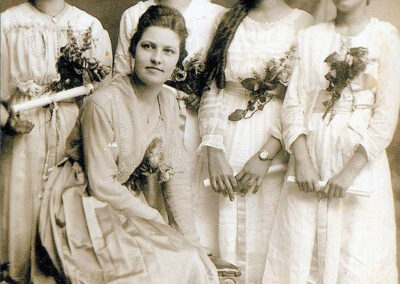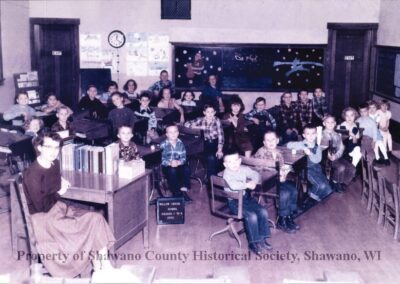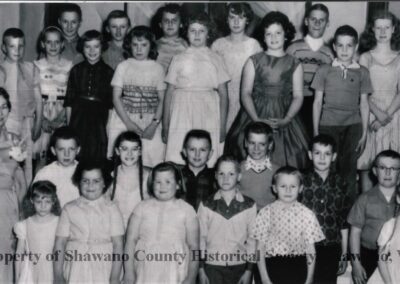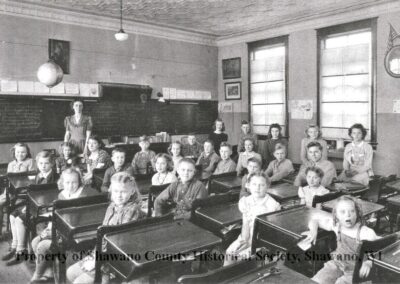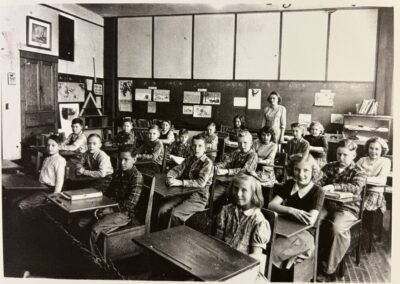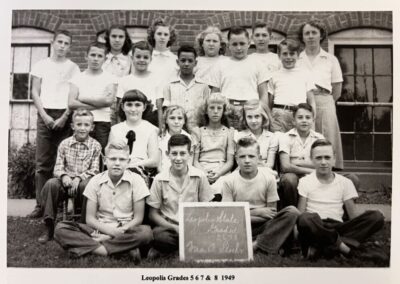Photo Gallery
June 1919, the Hermansfort School 8th grade graduation. In this photo, Gertrude Schuster, Adelia Brei, Helen Ready, Laura Baumann, and teacher, Mabel Luecke Schmidt. Hermansfort School is now the town hall located at highway 29 and county highway U.
Willow Creek School (Town of Herman) grades 1-6 taken in 1953. Front row: Larry Natzke, Orville Westphal, Marshal Conradt, Marvin Richter, Mary Lutzow, Nathan Anker, Joanne Ringel, Darlene Lauke Second row: Ronald Laude, Robert Westphal, Mark Krause, Nancy Peebles, David Krause, Joseph Anker, Philip Fleigle, Tom Lutzow Third row: Susan Fleigle, Charles Bartz, Mary Anker, Ronald Peebles, Jean Westphal, Janice Lohrentz, Constance Balke Back row: Gerald Peebles, Diane Jung, Roland Anker, Dorthy Suehring, Doris Richter, John Krause
1963 Willow Creek School 1st row: Rammona Lemmens, Trudi Jung, Ludene Balke, Steve Peebles, Jerry Gallnow, Laurie Lemmens 2nd row: Bob HabecK, Gloria Lemmens, Larry Laude, Larry Anker, George Peebles, Jeff Gollnow 3rd row: Jeff Teske, Judi Anker, Kathy Habeck, Debbie Teske, Peggy Jung, Kathy Wesphal, Dan Pebbles 4th row: Mike Dillenberg, Jim Gallow, Patti Jung, Shirley Westphal, Howard Anker, Kathleen Lemmens Teacher: Mrs. Olson
Hermansfort Public School class off 1945-1946. Right to Left Row 1: Carolyn Hoernke, Marion Richter, Gwendolyn Schweitzer, Florence Hoernke Row 2: Shirley Webster, Marilyn Ringel, Willard Kriefall, Elaine Mode, Howard Schultz, Violet Heling, Donnabelle Schultz, Teacher – Irma Paiser Row 3: Yvonne Ringel, Darlene Baumgartner, Howard Richter, Roy Webster, Mary Raasch, Delmar Baumgartner Row 4: Donald Baumgartner, Robert Huebnerm, Alice Hoernke, Wallace Heling Row 5: Dolores Raasch Janice Schweitzer, Doris Webster, Lowell Richter, Ila Mae Kroll
LEOPOLIS SCHOOL, (GRADE? 4 5 6) 1945 This classroom was known as the upper room. The partition in the back of the class room could be raised. A state was erected in the front for X-mas programs and other entertainment events. Row 1: Carol Raddant, Pat Lamancik, Roger Heinl, Sharon Brunner Row 2: Roger Peterson, Warren Schmidt, Ed Lamancik, Myrtle Pevonka, James Richards, Carol Kristof Row 3: unknown, Lyle Ashenbrenner, Bob Richards, unknown, Jim Sousek Row 4: Roger Weisnicht, Dale Huebner, ?, Don Oakes Teacher: Esther Buss
LEOPOLIS GRADE SCHOOL, GRADES 5-8 – 1945 Front row 1: Bob Richards, Roger Weisnicht, James Sousek, Lyle Ashenbrenner. Row 2: Ron Kazda, Mary Ann Keehan, Marlea, Kazda, Jo Ann Raddant, Pat DeBaker, Tom Brunner. Row 3: Jack Schmidt, Donald Brunner, Roger Peterson, Donald Oakes, John Pevonka. Back row 4: Warren Schmidt, Myrtle Pevonka, Eleanor Ashenbrenner, Carol Kristof, James Richards, Opal Stoehr
Herman Township Schools
by Jane Glenz
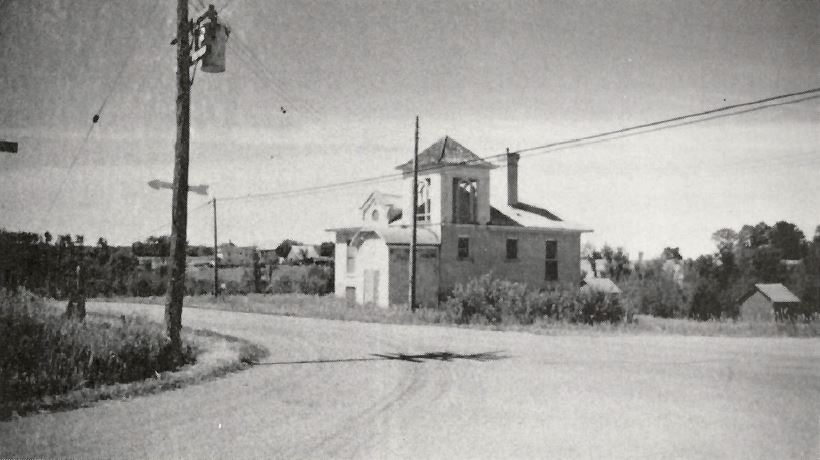
HOHN SCHOOL
The Hohn School got its name from the Hohn family which lived next to the school. It was known as District 2, Town of Herman.
When the district was started in the late 1800’s there was some disagreement as to the site of the school. Originally the site selected was on top of what is known as Hafferman’s Hill because this was the center of the district. This not being an ideal place for a school, two other sites were considered. The people at the southern part of the district wanted it to be built across from the present Elias Lutheran Church. It was finally agreed to build it a mile north of this church on its present location. The land was leased for 99 years from August Butt who homesteaded the property.
The first building was a frame structure 26 by 50′ built in 1874 for $200. This building was sold and used as a garage and shed.
The present school was built in 1915. The school room proper was 32′ by 36′. In 1919 a front entrance was added to protect the door from snow and ice.
The enrollment varied through the years. In the early 1900’s there were 85 pupils enrolled. This was because the children from the Range Line and Lyndhurst districts attended the Hohn School. Later these districts built their own schools. When the school integrated with District 8 there were 16 pupils. In 1961 the enrollment dropped to 12. The school was then closed and the children transported to the Gresham schools.
One of the citizens recalls going to school at the age of four. He was not able to speak the English language which made it very difficult for the teacher. In many cases the German language was spoken at home so the children entering school had little knowledge of the English language.
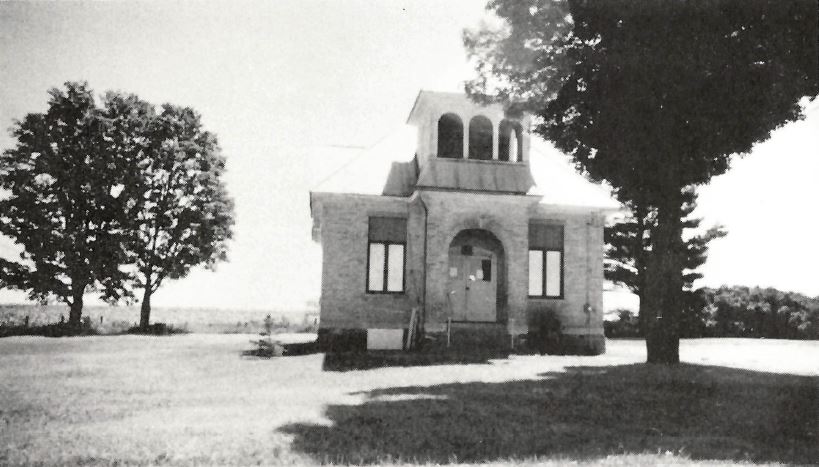
HERMANSFORT SCHOOL
Shortly after the close of the Civil War, in 1864, many people, mostly German extraction, immigrated from abroad and temporarily settled in southern Wisconsin and the Milwaukee area. Because of lack of employment, they journeyed northward and either claimed homesteads, then available, or bought tax defaulted lands to establish their new homes which, for many, became permanent homes.
Water, food, roads, school and church were the pressing needs of the early settlers. In 1870 the Town of Herman was organized, named after the Sons of Herman, a fraternal organization. The same year, School District No. l, now Hermansfort was also organized and legally established. This was an answer to many prayers.
The location of the first school appears to have been quite a struggle between families living north and south. The south had an influential man on the board and early in the spring, he and his supporters began to clear a parcel of land for a schoolhouse site one-half mile south of the present location. However, at the July meeting, the south lost to the north and Mr. Berdoll deeded the acre of land to the School District #1 and before October l, 1870, a small 16′ by 24′ log building had been completed and school could begin.
Dr. W. H. Cantwell, Sr. had passed the teacher’s examination and accepted a contract to teach school for a five-month period at $24 per month. At that time, it was a common practice to have two terms of school, five months during the winter and two months during the summer.
The hardest work for the teacher was teaching the English language as the settlers were of German extraction and could not speak or understand English.
By 1884, the old log building was too small to hold all of the children. So, a new frame building 18′ by 36′ was built. The old log building was sold and moved piece by piece and built up again on Highway 29 for a residence.
The new frame building served as a schoolhouse until 1907, when a brick veneer building was erected. The frame building was sold and moved to the south side of the grounds and served as the Town of Herman town hall. It served as town hall until 1924 when a tornado destroyed the building.
Not until 1892 were the two terms united and a nine-month term adopted. The school was closed in 1968 and served as a town hall. Recently it, too, was torn down.
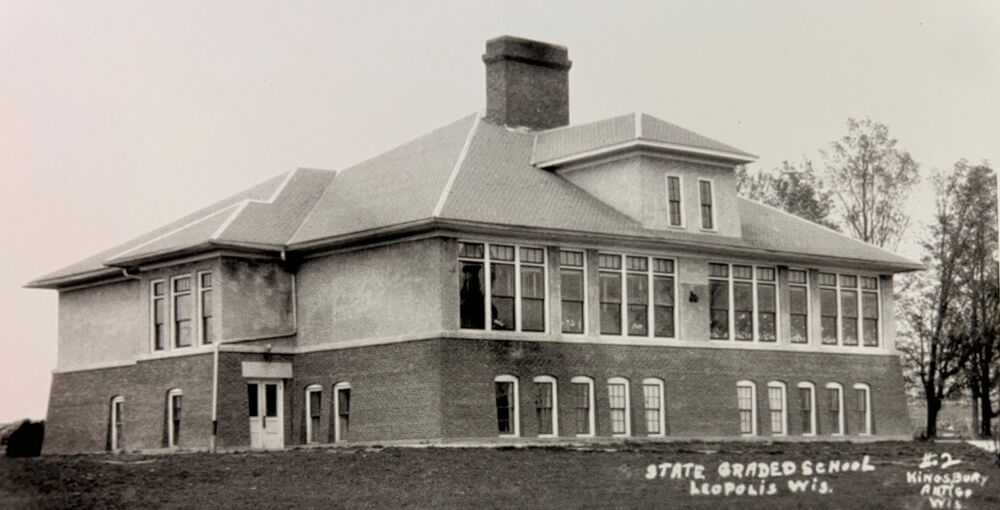
LEOPOLIS SCHOOL
District #3 Town of Herman
By Rita Kristof
In 1871, one of the first actions of the town of Herman was to establish school districts within the township. One such district was established to accommodate the rapidly growing student population of the Leopolis area. According to the town board: the third district shall consist of Sections 28, 29, 30, 31, 32, and 33. However, in later years the Leopolis School District became a joint school district consisting of sections of the Town of Herman, The Town of Grant, the Town of Pella and the Town of Seneca first annual meeting of District # 3 was held at the home of F. A. Deleglise on September 21, 1871. At that meeting, six qualified electors chose S.T. Hale as chairman of the school by a vote of five to one. Antoine Deleglise, unanimously elected as clerk and Frank Nosek, chosen by a vote of five to one as the first district treasurer.
Once the positions were filled, the school board had to get to the business of preparing a school budget. School boards have not changed much over the years, as the topic stimulated a heated debate. The budget for the first year consisted of General Purpose $112.50, Stove $7.50, Desks $7.50, seats $7.50, blackboard $3.75, Dictionary 59.00, Eight cords of wood $6.50, Teachers salary $31.23 and Miscellaneous of $18.75 for a total of $204.00. In addition to the budget the length of the school term was decided at this meeting. For the first year, the students were to attend school five months. Two months in the winter and three months during the summer.
The earliest records available from the Leopolis School show that in 1890 Miss Alma Sanborn and Miss Flora Wheeler were hired to the teach the five month school term and they were to be paid $35. per month. Those contracts were signed by L. D. Roberts, County Superintendent of Schools.
The original frame school had been built around 1871, at the time of the creation of the school district. However, the rapid growth of Leopolis by the turn of the century necessitated the construction of a new school house. The student enrollment had grown to over fifty, and the one-room school house was no longer able to meet the community’s educational needs. At the annual meeting it was decided to construct a new schoolhouse. At that time, the old school was moved across the street to be refurbished as a residence. (The original building still stands today as a part of a home owned by E.G. Kucksdorf. While construction continued on a new two story building from August 1897 to September 1898, and since the students were without a school building for a complete school term, lessons were temporarily held in Schmahl’s Hall, located on the east side of the village. A dedication ceremony was finally held in the fall of 1898 and the new schoolhouse was ready for use.
The school district officers had been responsible for providing the Leopolis area students with the most modern facilities of the time. In 1900, those officers wee: Joe Kadletz, Director, Jacob Cerveny, Treasurer and William Reschke, Clerk. J. P. Heini later was appointed to complete the term of Kadletz.
Students that did not live within the boundaries of the school district could attend the Leopolis School District if there was room to accommodate them and they paid a tuition of $10.00. By 1910 the school term had been extended to nine months.
The earliest records of the students eligible to attend the Leopolis School were: Pella 30: Grant: 24 Seneca: 14 and Leopolis: 78. The ages of the eligible students ranged from age 5 to age 19. The school census for the 1910’s showed a predominance of male students in the school and also showed a relatively stable student population.
New developments in technology had made the second Leopolis primitive by comparison to other, newer area schools. Because of this a special meeting was called on January 12, 1920, for the purpose of building a new school. The proposal was overwhelmingly supported by the voters, and the resolution [assed by a vote of thirty-four in favor and only six against. The necessary funds were borrowed for the State Trust Fund at a rate of 4% per year.
After letting out bids, it became apparent that considerably more money would need to be appropriated to construct a school of the size and quality desired by the district. Therefore, another special meeting was called on May 20, 1920 to authorize an additional loan of $15,100. A portion of the additional funds, $1100, involved additional expenditures for the new site for the new schoolhouse. The other $14,000 involved additional expenditures to defray the costs of construction. Illustrating the commitment of the school districts voters the appropriations were overwhelmingly supported. The additional money for the new site was approved by a vote of thirty-seven in favor and two against. The bigger question of the additional $14.000 for the school building was approved by a vote of thirty-five in favor and five against.
After the decision to build a new school, district voters decided to keep the old school house standing while the new one was being built. The two large halls large enough to accommodate the large number of pupils in the school were Schmidt’s Hall and Presl’s Hall. However, both were used each week for various social events from dances to movie picture shows in the community and because their use was considered essential for the recreational well-being of the community it was decided the school would be built one lot west of the old school, and the old school would be razed upon completion of the new school. There were 134 students that attended the new school and again the ranged from age 5 years of age to 19 years of age.
Several improvements were made to the new school in 1921, many of which involved modernizations that had just become available. The Leopolis Progressive Society purposed the addition of a stage to the school. William Reschke was authorized to purchase lumber and arrange for the construction but not to exceed the cost of $25.00. Another improvement was a new, electric gong to replace the tradition, manual ringing of the bell. At the annual meeting of July 5, 1921, the district voters approved the purchase of an electric bell and the ringing of it to start the school date. In addition, a five-inch thick, concrete sidewalk was constructed by William Mitchell at a cost of $234.00.
Another improvement was the installation of the plumbing system. In July 1921, The school district signed a contract with T. A. Freiberg of Clintonville to dig a well for a six-inch pipe that would supply water for the school. The School would use this water for laboratories, drinking fountains and to flush toilets. A six inch pipe was sunk and the whole system was operational for a total cost of $1440.
In 1924, the old schoolhouse was sold to Bernard Heling of Pella for $200. As part of the agreement on the sale of the building, Heling agreed to preserve the storm windows which had recently been added. In addition, he agreed to have the building razed in one Year.
Records from the 1930’s school board meetings show gradual improvements to the school. A new roof was put on in 1932 for a cost of $1006.39. Labor costs of $147.70 as paid to local labors Art Thiel, Walter Getshow, Herman Reschke, Matt Asenbrenner and George Hoffman. Other improvements were grading of the grounds for easier lawn mowing, outside play equipment and a flag pole.
Along with the graded school in Leopolis, there was also a two-year high school in Leopolis. In 1923, ninth and tenth graders who were non-residents of Herman Township were required to pay $8.00 tuition, while non residents grade scholars paid $2.00 tuition fee. The Leopolis High School ceased operations after the 1943-44 school year, and students were transferred to either Shawano or Marion depending on their area residence.
Unfortunately, the records from 1950 to the time i obed c. possibly because of a fire in the Marion High School. We learned from former teachers and students, however, that the school continued using 2 rooms and 2 teachers and that the grade school continued with eight grades until 1949 when they became part of the Integrated School System. At that time the eight grade graduates went on to Gresham High School. In 1950 the Leopolis School was consolidated into the Marion School District. Leopolis continued in the Marion School District with 8 grades, which included the students that were transferred from the Seneca School when it closed in 1950 and the students from the Pella School area that closed in 1964. In the late fifties the seventh and eight grades joined their area classmates at the Marion High School. In 1978, like many county schools, the Leopolis School was closed with 1 thru 6 transferred to the Marion Grade School.
During the school terms of 1962 thru 1966 there was a half day kindergarten class at the Leopolis School. The students consisted of the Leopolis, Pella and Caroline area. This was apparently due to the overcrowding at the Marion Grade School and the construction of a new building in Marion, Mrs. Carol Jacobson apparently taught for 1 year and Mrs. Shirley Klaeser for three years. Mrs. Klaeser, a Caroline resident, shared with us that for at least one year she had some type of agreement with the district and was able to pick up the students on her drive from Caroline to Leopolis.
We could not complete this story with out mentioning Mr. George Hein the faithful and friendly janitor at the Leopolis School and also a bus driver many years for the Marion School District. Also, Mrs. Leona Ashenbrenner and Mrs. Mary Zimdars who served the hot lunch that was transported from the Marion School
The Leopolis School property is now the property of the township of Herman. It has as a shelter, picnic and play area and is a part of the A.N. Brunner Baseball Park. It is maintained with the help of the Leopolis Booster Club and the Leopolis Baseball Club.
Ref: From Sawmills to Villages (Marion High Students and Teacher Robert McDivitt)
Thanks to Ed and Adeline Asenbrenner and Glen Ashenbrenner for helping to identify the early students

